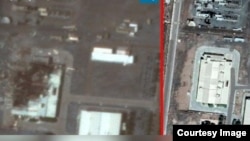A website close to Iran's Supreme Council of National Security (SCNS) has published a commentary on the blast at Iran's "centrifuge assembly line" in Natanz which says the incident was “a deliberate attack”.
However, Nour News added, "an air strike on the Natanz plant is almost impossible”, due to strong air defences.
The is the first time a source close to the Iranian government acknowledges there has been an "attack" on the nuclear establishment.
The website said the publication of the commentary on Tuesday July 7 was aimed at shedding light on the ambiguities concerning the incident.
In recent days there have been explosions at two of Iran's top security nuclear and military facilities – Khojir east of Tehran and Natanz in Isfahan province.
Iranian authorities said the incident at the first site was caused by the explosion of a gas storage tank but have delayed thee announcement of the cause for the Natanz incident "for security reasons".
It's been widely suggested that Israeli drone or missile attacks were responsible for the explosions. Israel has not commented on the issue but in similar cases, they have neither confirmed nor denied reports of their involvement.
Nour News said that the Natanz plant is being constantly protected by "defensive anti-aircraft guns," adding that Iran's powerful air defense equipment including the S-300 missile system are stationed at other parts of the country, "near the borders and sensitive areas."
The website noted that the Iranian government has built the Fordu site underground in a mountainous region to reduce its vulnerability in case there is an air strike.
Nour News also claimed that "there are a lot of similarities between the incident in Natanz and the assassination of General Soleimani" but did not elaborate further except saying, "the combination of intelligence, logistics, action and the volume of destruction" as part of those similarities. It added these factors strengthen the possibility of "a deliberate attack."
Soleimani was killed in a U.S. drone strike just outside Baghdad Airport in January.
Meanwhile, on June 5, the New York Times quoted an unnamed IRGC commander as having said that the blast was caused by a powerful explosion inside the building which heavily damaged the Natanz nuclear establishments.
Nour News also offered some information about the building where the centrifuge assembly line was located. The site said its construction started in 2013 but work was suspended following the 2015 nuclear agreement with the world powers, adding that the site was finally completed in July 2018.
This comes while Behrouz Kamalvandi, the spokesperson for the Iranian Atomic Energy Organization said on July 5 that the site was under construction when the blast happened.
Nour News explained that the building served as home to Iran's modern centrifuges of IR-4, IR-4 and IR-6 generations, adding that another building was also built for taller centrifuges.
The commentary on Nour News added that the space was capable of hosting 60 centrifuges. The most important test that took place there was the speed test using modern equipment, the commentary added.
Earlier, Channel 13 of Israeli television quoted officials as saying that the blast delays Iran's plans to boost uranium enrichment for two months, as the laboratory that developed high speed centrifuges was demolished in the blast.
Noor News added that "The attack was launched 2 AM to make sure that there were reduced security arrangements in place and in order to prevent casualties. On the other hand, an attack on the underground enrichment site would have entailed danger of radioactive leak and international consequences. So, the attack was carried out in the [above ground] building where there were no nuclear material."
The new information about the attack on the nuclear site in Natanz followed last week's announcement by the SCNS which said, "the cause of the blast will not be announced for the time being due to security concerns."






